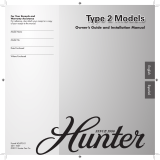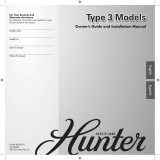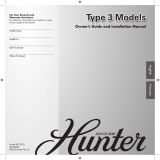
Manhattan Remote Control Ceiling Fan
Assembly Instruction - Please keep for future reference
Important - Please read these instructions fully before starting assembly
If you need help or have damaged or missing parts, call the Customer Helpline: 0345 640 0800
432/8317
432/5114

reference
Important
WASHERS
MOUNTING
PLATE
FIXING SCREWS
SCREWS
EARTHED
MAINS SUPPLY
FIGURE 1
MOUNTING PLATE
CANOPY
SCREW
BAYONET
SLOT
ROUND HOLE
RECEIVER
BALL JOINT
CANOPY
FIGURE 2
DOWNROD
EARTH TERMINAL
LIGHT SUPPLY
(RED)
WIRES TO FAN
INCOMING MAINS SUPPLY
N BLUE
L BROWN
(GREEN / YELLOE)
RECEIVER
N
L
FIGURE 3
Please read these instructions carefully before attempting to install this
ceiling fan. It is also advisable to keep these instructions in a safe place
for future reference. Before installing and using this ceiling fan, read the
list of Do and Don’ts below.
For your safety, this product must be installed in accordance with Local
Building Regulations. If in any doubt, or where required by the law,
consult a competent person who is registered with an electrical
self-certificatin scheme. Further information is available online or from
your Local Authority.
Crosshead and slotted screw drivers
1 X Max. 40W E14 bulb (Not included)
Step ladder
Insulatiing tape
Remove the upper polystyrene cover from the box. Take the motor out
of the box and place it on the polystyrene cover, or on a soft padded
surface to protect it during the installation procedure. keep all packing
material for future protection in transit.
1. Unscrew the four screws on the ceiling canopy to release the mounting
plate (Figure 1). Secure the mounting plate to a ceiling joist, or an equally
secure ceiling structure using the two wood fixing screws and washers
supplied. The support for the mounting plate must be capable of safety
and securely holding the moving weight of the fan. Note that additional
strengthening of the joist might be necessary.
2. For best fan performance and safety, make sure the mounting plate is
fitted to a level ceiling joist or ceiling support. If the mounting position is
not level, hard packing material should be used to make the plate level.
1. Hang the ball joint and the fan onto the bracket. Ensure the groove in
the ball is lined up with tab on the hanger bracket. With the fan
suspended in this manner, you can now make the appropriate electrcal
connections.
See the CONNECTION TO THE LIHGT CIRCUIT section.
2. Insert the remote control receiver between the bracket and the
downrod. And the sensor as shown. (Figure 2)
3. Fix canopy onto the bracket by tightening the screws. (Figure 4)
ASSEMBLY & FITTING INSTRUCTIONS
Do not use the ceiling fan and open gas heating appliances in the same
room at the same time. It is important that the correct electical connec-
tions are made and that the mounting plate is fitted to an adequate cei-
ling support. Ceiling fans are heavy, so it is important that they should
be suspended securely. If in any doubt the installation of this product
consult a qualified electrician.
ASSEMBLY & FITTING INSTRUCTIONS
IMPORTANT
CAUTION
LOCATION
When deciding on the location for your ceiling fan make sure that there
will be plenty of room for the rotation of the fan blades and that no obs-
tacles are likely to get in their way. The distacne between the fan blades
and the floor should be at least 2.3m (7½ft).
TOOLS AND MATERIALS REQUIRED
UNPACKING
INSTALLING THE MOUNTING PLATE
INSTALLING THE FAN

Important - Please rFAN e instruct
keep for future reference
MOUNTING PLATE
BAYCNET
LOCATING
SLOT
SCREW
HCLE
GROOVE
CEILING
CANOPY
DOWNROD
BALL JOINT
FAN MOTOR HOUSING
FIGURE 5
FIGURE 6
BLADE
SCREW
LAMP HOLDER
LAMP SHADE
FAN MOTOR
HOUSING
FAN MOTOR
HOUSING
LAMP
HOLDER
SCREW &
STAR WASHER
TAB
INFRARED
RAY RECEIVER
FIGURE 4
The fan must be switched off before this slide switch, located on the side
of the switch housing is operated.
Switch upwards for REVERSE winter operation.
Switch downwards for FORWARD summer operation.
1. Insert 40W E14 bulb (not included) into the lamp holder. Do not use a
higher wattage bulb.
2. Install the lamp shade onto the lamp holder by rotating the lamp
shade clockwise. (Figure 6)
3. The light is switched on and off by the use of remote control.
Wipe with a soft dry cloth or use a soft brush to remove dust. Care
should be taken that no water or moisture gets into the ceiling fan.
Do not use water to clean the ceiling fan. Do not use metal polish or
abrasive cleaning materials on any part. A small amount of furniture
polish can be used to clean the fan blades. When cleaning the fan
blades do not apply too much pressure on the them. It is recommended
that you support the ends of the blades when you clean them.
Ensure that all electrical connections are tight and that no loose strands
are left out of the terminal block. Cover the terminal block with insulat-
ion tape. Warning: If there are only two wires in your existing mains
wiring, this means that there is no Earth. Under no circumstance should
you wire up this fitting without using an Earth connection.
Ask a qualified electrician to provided an Earth facility.
The installation must be provided with a double pole switch.
ASSEMBLY OF THE FAN BLADES AND LAMP HOLDER
1. Install the fan blades sets onto motor by tightening the hexagonal
screws and spring washers.
2. Connect the upper plug connector from the motor to the lower plug
connector from the lamp holder.
3. Secure the lamp holder onto the fan motor housing by tightening
the 3 set screws. (CAUTION: Make sure the set screws are fitted
properly into the key slots) (Figure 5)
Attention: Ensure the star washers to be secured tightly to lamp holder
with set screws.
FITTING THE LIGHT
REMOTE CONTROL
Use the remote control transmitter to change the speed of the fan and to
switch the light and fan on or off. Replace the batteries by sliding the
battery compartment cover on the romote control transmitter in the
direction of the arrow, fit 2 *AAA batteries, ensure the polarity of the
batteries match with the figures shown in the battery compartment.
(Note: Batteries NOT included.) Replace the battery compartment cover.
Always ensure the battery compartment cover is closed properly.
Don’t expose the remote control to direct sunlight.
Don’t attempt to recharge non-rechargable batteries. There are special
rechargable batteries, which are clearly marked with.
Don’t dispose of batteries in fire to avoid explosion.
REVERSE CONTROL
CLEANING
Ensure electricity is switched off at the mains before installing or main-
taining this fitting. Any switches connected to the ceiling fan must con-
form to the necessary British Standards. If you are not sure how to wire
the ceiling fan consult a qualified electrician. For the basic means of
wiring the ceiling fan, use the following procedure (Figure 3)
Blue or black (Neutral) to the terminal marked N
Brown or Red (Live) to the terminal marked L
Green/Yellow or Green (Earth) to the terminal marked
Ensure that earth terminal of the canopy is securely connected to the
earth pole of the terminal block.
CONNECTION TO THE LIGHT CIRCUIT

reference
ASSEMBLY & FITTING INSTRUCTIONS
• Do ensure that the ceiling joist or ceiling support will holde the moving weight of the ceiling fan.
• Do ensure that all electrical connection are in accordance with relevant safety and government regulations.
• Do use or consult a qualified electrician if you are uncertain about wiring this ceiling fan.
• Do use a qualified electrician for installation to a concrete ceiling.
• Do switch off the fan before using the reverse switch.
• Don’t use the ceiling fan and open gas heating appliances in the same room at the same time, otherwise harmful
gases might be circulated.
• Don’t fit in rooms where the distance between floor and blades is less than 2.3m (7½ft). Allow at least 500mm between
the blade tip and any wall or fumishings.
• Don’t fit in bathrooms or areas where the fan might become wet.
• Don’t insert anything into the fan blades when they are rotating.
• Don’t use a dimmer switch with this ceiling fan. This could damage the dimmer and the fan.
• Don’t use this fan with any speed control device as it could be a fire risk.
• Don’t use the ceiling fan for any other purpose than described in this instruction sheet.
• Don’t modify or alter the ceiling fan.
IF IN ANY DOUBT CONSULT A QUALIFIED ELECTRICIAN.
Fan 45W Light fitting 1 X 40W. Total 85W. 230~50Hz.
Do not attempt to repair this unit yourself repairs can only be made by qualified service personnel. Repairs by
unqualified persons will invalidate the guarantee, and may result in accident or injury.
WASTER ELECTRICAL PRODUCTS SHOULD NOT BE DISPOSED OF WITH HOUSEHOLD WASTE.
PLEASE RECYCLE WHERE FACILITIES EXIST. CHECK WITH YOUR LOCAL AUTHORITY FOR RECYCLING
ADVICE.
Fan will not start
CAUTION: Make sure mains power is switched off before you carry out these checks.
1. Check the main and branch circuit fuses or contact breakers.
2. Check power supply wires to the fan are secured.
3. Check reverse switch is firmly in the up or down position.
Fan sounds noisy
Allow a break-in period of 24 hours. Most noise associated with a new fan will disappear after this period.
1. Check to make sure all screws to the fan motor housing are secure but not overtight.
2. Check mounting plate screws are tight and securely fitted to ceiling joist or ceiling support.
3. Check that the screws which attach the blade holder arms are tight.
4. Check that the lamp and lamp shade are properly fitted to the lamp holder.
5. A dimmer switch should not be fitted to this ceiling fan. If this ceiling fan is connected to a dimmer switch it will make
noises when the fan light is switched off. Remove the dimmer switch.
Fan wobbles or shakes excessively
Please note that a small amount of wobble is natural and should not be considered a problem.
All blades are weighed and grouped by weight. Natural wood varies in density which could cause the fan to wobble
even though all blades are weight matched. The following procedure should eliminate most of the wobble. Check for
wobble after each step.
1. Check that fan blades are screwed firmly into the blade holder arms.
2. Check that all blade holder arms are tightened securely to the fan housing.
3. Most fan wobble problems are caused when blade tracking levels are unequal. Blade tracking may be checked
simply by use of a length of timber. Place the timber vertically against the ceiling and even with the outside leading
edge of the blade. Mark the distance from the edge of the blade to the ceiling. Turn the blades slowly by hand to check
the remaining blades. If a blade is not in alignment, the blade holder arm may be gently bent up or down to be in-line
with the other blades. Allow the fan to operate for ten minutes to check if this problem has been solved.
4. Make sure the mounting plate is securely fixed to the ceiling joist.
5. Check that the ball joint engages with the groove on the ceiling canopy.
TROUBLE SHOOTING
DO
DON’T
SPECIFICATIONS
REPAIRS

No.3 "Shield Anchor" Wall Plug
Heavy Loads
For use with heavier loads such as TV
& HiFi Speakers and Satellite Dishes etc.
No.4 "Cavity Fixing" Wall Plug
For use with plaster board partitions or
hollow wooden doors.
No.5 "Cavity Fixing - Heavy Duty"
Wall Plug
For use when fitting or supporting heavy
loads such as shelving, wall cabinets,
coat racks.
IMPORTANT:
When drilling into walls always check that there are no
hidden wires or pipes etc. Make sure that the screws and
wall plugs being used are suitable for supporting your unit.
Consult a qualified tradesperson if you are unsure.
HINTS:
1) General Rule Always use a larger screw and wall plug if you are not sure.
2) Ensure you use the recommended drill bit to match the wall plug and hole size.
3) Ensure you drill the hole horizontally, do not force the drill or enlarge the hole.
4) Take extra care when drilling high walls, ceilings and ceramic tiles. Ensure the plug is fitting below the ceramic
tile to avoid splitting or cracking.
5) Ensure wall plugs are well fitted and are a tight fit in the drilled hole.
Types Of Walls
You can use one of the following types
of wall plug if your walls are made of
brick, breeze block, concrete, stone,
wood or plaster board.
No.1 "Standard" Wall Plug
General Wall Materials
These come in various sizes and are made
from plastic or sometimes wood fiber.
No.2 "General Purpose" Wall Plug
Aerated / Breeze Block
Generally aerated blocks should not be
used to support heavy loads, use a
specialist fitting in this case.
For light loads, a General Purpose Plug
can be used.
No.6 "Hammer Fixing" Wall Plug
For use with walls stuck with plaster
board. The hammer fixing allows it to
be fixed to the wall rather than the plaster
board. Always check the fixing is secure
to the retaining wall.
CARE & MAINTENANCE
SAFETY
Always check the fitting and
location to ensure your safety in
and around the home.
FITTING
From time to time check the fitting
to ensure the wall plugs or screws
do not become loose.
Wall Mounting & Fixings
A Guide to
-
 1
1
-
 2
2
-
 3
3
-
 4
4
-
 5
5
Argos SH0012 User manual
- Type
- User manual
- This manual is also suitable for
Ask a question and I''ll find the answer in the document
Finding information in a document is now easier with AI
Related papers
Other documents
-
River of Goods 20606 User manual
-
Endon 97374 Operating instructions
-
Y Decor AISLEE-MB Operating instructions
-
Eurolux F40BBO Owner's manual
-
Eurolux F36W Owner's manual
-
Ross LN2RTA800 User manual
-
 Hunter Fan 28752 Owner's manual
Hunter Fan 28752 Owner's manual
-
 Hunter Fan 20492 User manual
Hunter Fan 20492 User manual
-
 Hunter Fan 27529 Owner's manual
Hunter Fan 27529 Owner's manual
-
Casablanca Tribeca Installation guide









